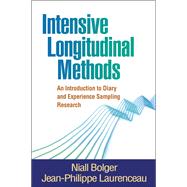Summary
A complete, practical guide to planning and executing an intensive longitudinal study, this book provides the tools for understanding within-subject social, psychological, and physiological processes in everyday contexts. Intensive longitudinal studies involve many repeated measurements taken on individuals, dyads, or groups, and include diary and experience sampling studies. A range of engaging, worked-through research examples with datasets are featured. Coverage includes how to: select the best intensive longitudinal design for a particular research question, model within-subject change processes for continuous and categorical outcomes, distinguish within-subject from between-subjects effects, assess the reliability of within-subject changes, assure sufficient statistical power, and more. Several end-of-chapter write-ups illustrate effective ways to present study findings for publication. Datasets and output for the examples are available for readers' use at the companion website. The website also includes HLM, MLwin, and R code as an alternative to the SPSS, SAS, and Mplus code presented in the book.
Author Biography
Niall Bolger, PhD, is Professor and Chair of Psychology at Columbia University. He is a Charter Member and Fellow of the Association for Psychological Science and a Fellow of the Society of Experimental Social Psychology and the Society for Personality and Social Psychology. Dr. Bolger studies adjustment processes in close relationships, using intensive longitudinal methods and laboratory-based studies of dyadic behavior, emotion, and physiology. He also studies personality processes as they are revealed in patterns of behavior, emotion, and physiology in daily life. Finally, he is interested in statistical methods for analyzing longitudinal and multilevel data.
Jean-Philippe Laurenceau, PhD, is Professor of Psychology at the University of Delaware. He is an appointed member of the Social, Personality, and Interpersonal Processes grant review panel of the National Institutes of Health. Dr. Laurenceau's research focuses on understanding the processes by which partners in marital and romantic relationships develop and maintain intimacy in the context of everyday life. His methodological interests include intensive longitudinal methods for studying close relationship processes and applications of modern methods for the analysis of change in individuals and dyads.
Table of Contents
1. Introduction to Intensive Longitudinal Methods
1.1 What Are Intensive Longitudinal Methods?
1.2 Applications of Intensive Longitudinal Methods
1.3 Why Use Intensive Longitudinal Methods?
1.4 Goals for This Book and Intended Audience
1.5 Organization of This Book
1.6 Recommended Readings
2. Types of Intensive Longitudinal Designs
2.1 Chapter Overview
2.2 Strengths of Intensive Longitudinal Designs
2.3 Types of Research Questions
2.4 Types of Designs and Prototypical Examples
2.5 Limitations of Intensive Longitudinal Designs
2.6 Which Intensive Longitudinal Design Is Best for You?
2.7 Chapter Summary
2.8 Recommended Readings
3. Fundamentals of Intensive Longitudinal Data
3.1 Chapter Overview
3.2 An Example Dataset
3.3 Between-Subjects and Within-Subjects Levels of Analysis
3.4 Allowing for Between-Subjects Heterogeneity: Random Effects
3.5 Taking Account of Time
3.6 How Many Independent Units Are There in Intensive Longitudinal Datasets?
3.7 Choosing an Appropriate Zero Point For X
3.8 Chapter Summary
3.9 Recommended Readings
4. Modeling the Time Course of Continuous Outcomes
4.1 Chapter Overview
4.2 The Example Intervention Dataset
4.3 An Application of Linear Growth Curve Analysis
4.4 Example Write-Up of Intervention Study Data
4.5 Chapter Summary
4.6 Recommended Readings
5. Modeling the Within-Subject Causal Process
5.1 Chapter Overview
5.2 Conceptualizing a Within-Subject Causal Process
5.3 Example Daily Conflict and Intimacy Dataset
5.4 Multilevel Causal Model Linking Daily Conflict and Intimacy
5.5 Modeling a Process with Missing Repeated Measures Data
5.6 When the Intervals between Measurements Are Unequal
5.7 Example Write-Up of Daily Conflict Study Data
5.8 Chapter Summary
5.9 Recommended Readings
6. Modeling Categorical Outcomes
6.1 Chapter Overview
6.2 Exploring the Example Dataset
6.3 A Longitudinal Multilevel Model Linking Morning Anger to the Incidence of Daily Conflict in Couples
6.4 Implementation in SAS PROC GLIMMIX
6.5 Implementation in IBM SPSS GENLINMIXED
6.6 Implementation in Mplus
6.7 Chapter Summary
6.8 Recommended Readings
7. Psychometrics of Intensive Longitudinal Measures of Emotional States
7.1 Chapter Overview
7.2 Basic Ideas about Random Measurement Error
7.3 Making Use of Generalizability Theory
7.4 Making Use of Multilevel Confirmatory Factor Analysis
7.5 Chapter Summary
7.6 Recommended Readings
8. Design and Analysis of Intensive Longitudinal Studies of Distinguishable Dyads
8.1 Chapter Overview
8.2 Motivation for Studying the Everyday Lives of Dyads
8.3 Methodological and Design Issues in Intensive Longitudinal Studies of Distinguishable Dyads
8.4 The Multilevel Model for Intensive Longitudinal Data from Distinguishable Dyads
8.5 Example Write-Up of Dyadic Study Data
8.6 Chapter Summary
8.7 Recommended Readings
9. Within-Subject Mediation Analysis
9.1 Chapter Overview
9.2 Single-Level Mediation to Multilevel Mediation
9.3 Empirical Example
9.4 Implementing Within-Subject Mediation in Statistical Software
9.5 Interpretation of Results
9.6 Chapter Summary
9.7 Recommended Readings
10. Statistical Power for Intensive Longitudinal Designs
10.1 Chapter Overview
10.2 Approaches to Power
10.3 Power in Multilevel Models
10.4 Power for the Marital Therapy and Intimacy Example
10.5 Power for the Daily Conflicts and Intimacy Example
10.6 Power Analysis for the Daily Conflict Categorical Outcomes Example
10.7 Power for the Dyadic Process Example
10.8 Power for the Within-Subject Multilevel Mediation Example
10.9 Chapter Summary
10.10 Recommended Readings

